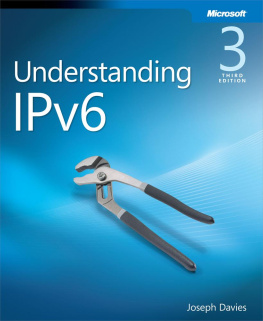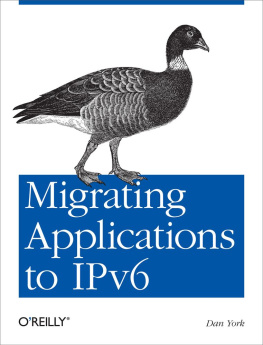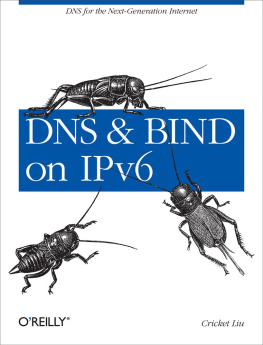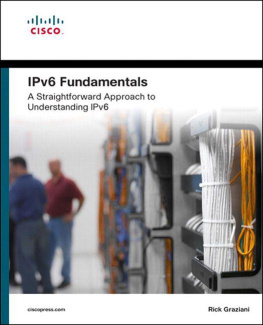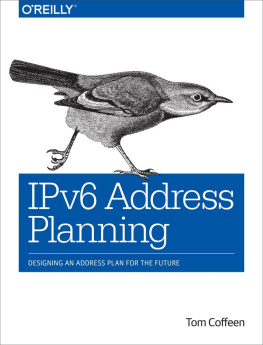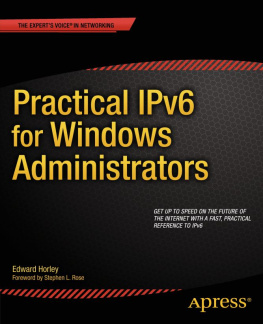Supplemental files and examples for this book can be found at http://examples.oreilly.com/9780735659148-files/. Please use a standard desktop web browser to access these files, as they may not be accessible from all ereader devices.
All code files or examples referenced in the book will be available online. For physical books that ship with an accompanying disc, whenever possible, weve posted all CD/DVD content. Note that while we provide as much of the media content as we are able via free download, we are sometimes limited by licensing restrictions. Please direct any questions or concerns to .
Foreword
When Joe first asked me to write a foreword for this latest edition of Understanding IPv6 , I looked to forewords from previous editions as well as other networking books, hoping to draw some inspiration. As will become increasingly obvious, my writing skills are not as honed as Joes.
Looking back was actually incredibly useful to me, because it clearly accentuated what has changed in the last few years. Microsoft has supported IPv6the next generation of the Internet Protocolsince its inception. We built support into the Windows stack, rearchitected our platform to enable developers to take advantage of IPv6, and over the past 10 years have been extending support across the company.
The Internet Protocol is the routing and transit protocol for the Internet, the largest and most important assembly of computing infrastructure of our time. IPv6 is going to make the Internet better, by allowing direct connectivity between host, whether they be family members video chatting or business information zooming between data centers.
We frequently take the time to remind everyone of our commitment to the realization of the end-benefits of IPv6. We do this for multiple reasons. We take pride in our work, certainly, and it gives us great pleasure to do our part to make technology a bit better. But perhaps more important, these reminders are evangelical; they assure customers, partners, and readers that IPv6 is something worthy of attention, worthy of adoption.
For many years, this was a difficult task. People didnt want IPv6. The growth and maturation of IPv4 survival strategies, such as large-scale network address translation, threatened the inevitability of IPv6 adoption. Thats the truth. Some in the networking world might try to revise the past 10 years: the broken routing equipment, the inadequate software, the legends of danger, IPv6 performance problems, IPv6 security problems, IPv6 money issues, and IPv6 zombies.
That darkness was real, but that darkness has past. In the past 24 months, weve made immense progress toward the goal of upgrading the Internet. IPv6 is no longer the next-generation Internet Protocol; it has become the now-generation Internet Protocol.
The World IPv6 Launch in June 2012 marked a key turning point in this transition. When you read this book, some of the most important web services in the world, not only from Microsoft but from across the technology community, are operational on the IPv6 Internet. Millions of users with IPv6-ready computers are using IPv6 to interact with these services and with one another. The apps, the operating systems, the routing infrastructure, the ISPs, and the services are not merely ready, theyre activated.
Joes book, in all its editions, has always been the IPv6 reference; its a fantastic medium for anyone interested in networking for understanding the Internet Protocol and its evolution. But as you read through this edition, I hope you gain not only the ability to understand and build networks by using IPv6, but also acquire a clearer perception of the changes happening all around you. The reality of how you search the Internet, play games with your friends, and access workplace resources is increasingly an IPv6 story.
When talking about the IPv6 story, we always note our commitment to ensuring that everyday users dont notice any change, or sense that their experience has diminished as we transition. It shouldnt matter whether your connection is over IPv4 or IPv6. You should have an Internet experience that is fast, reliable, and enjoyable, with the only evidence of the IPv6 transition being the lingering feeling that things simply got better.
After reading this book, youll likely be able to notice more than just that lingering feeling. The details, flags, and bits that make up IPv6 and the Internets evolution will become absolutely clear.
The Internet is going through an asynchronous, distributed, and transformative change at its very foundation. That change includes more than software or hardware; it involves a swath of people who work in networking, who use those systems, who architect networks, or who build apps.
By understanding IPv6 and this transformation, you contribute to its forward progress. Your journey becomes part of the greater tale of this technological evolution.
Thank you, and good luck.
Chris Palmer
IPv6 Program Manager, Microsoft
Preface
The first edition of this book began in the spring of 1999. At that time, I developed a set of slides and presented an Introduction to IPv6 course at Bellevue Community College in Bellevue, Washington, to four students. Although the turnout was not what I expected, the time spent learning IPv6, creating the slide presentation, and presenting IPv6 technology to these curious students proved to be an invaluable experience and prepared a firm foundation for future endeavors.
In 2000, as a technical writer for Windows, I wrote a white paper titled Introduction to IP version 6 that is published on the Microsoft Windows IPv6 website (www.microsoft.com/ipv6) and generally inserted myself in any documentation task associated with IPv6. I also developed and delivered an internal course called IPv6 Overview with help on the topic of Windows Sockets from Tom Fout. Beginning in October 2000, this one-day course was taught to Microsoft software design engineers, software test engineers, program managers, and technical writers.
My transition to a program manager for technical content development afforded me the time, focus, and experience to turn the IPv6 Overview courseware and numerous other white papers and articles about IPv6 into Understanding IPv6 (Microsoft Press, ISBN 978-0735612457), the first edition of this book. Between its first publication in November 2002 and January 2008, I continued to develop content for IPv6, supporting interim releases of IPv6 technology for Windows XP and the releases of Windows Server 2008 and Windows Vista, which have fully integrated IPv6 support for services and applications. The result of those efforts was the second edition of Understanding IPv6.
Between January 2008 and May 2012, I continued to follow the evolution of IPv6 in Windows, through Windows 7 and Windows Server 2008 R2 (writing detailed planning, deployment and troubleshooting information for DirectAccess) and on into the development of Windows Server 2012 and Windows 8. This third edition encapsulates all of these efforts.
It is my fervent hope that the work that I started in the spring of 1999 has culminated in a well-organized and readable text from which you can learn and understand the concepts, principles, and processes of IPv6.
Joseph Davies
Introduction
Due to the following recent events, the importance of Internet Protocol version 6 (IPv6) to the future of the Internet and organization intranets is now without question:

